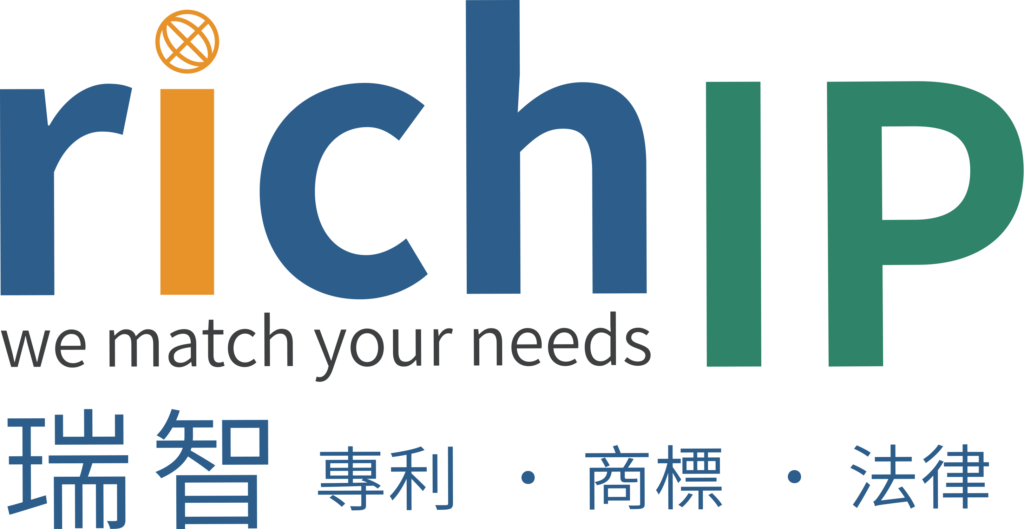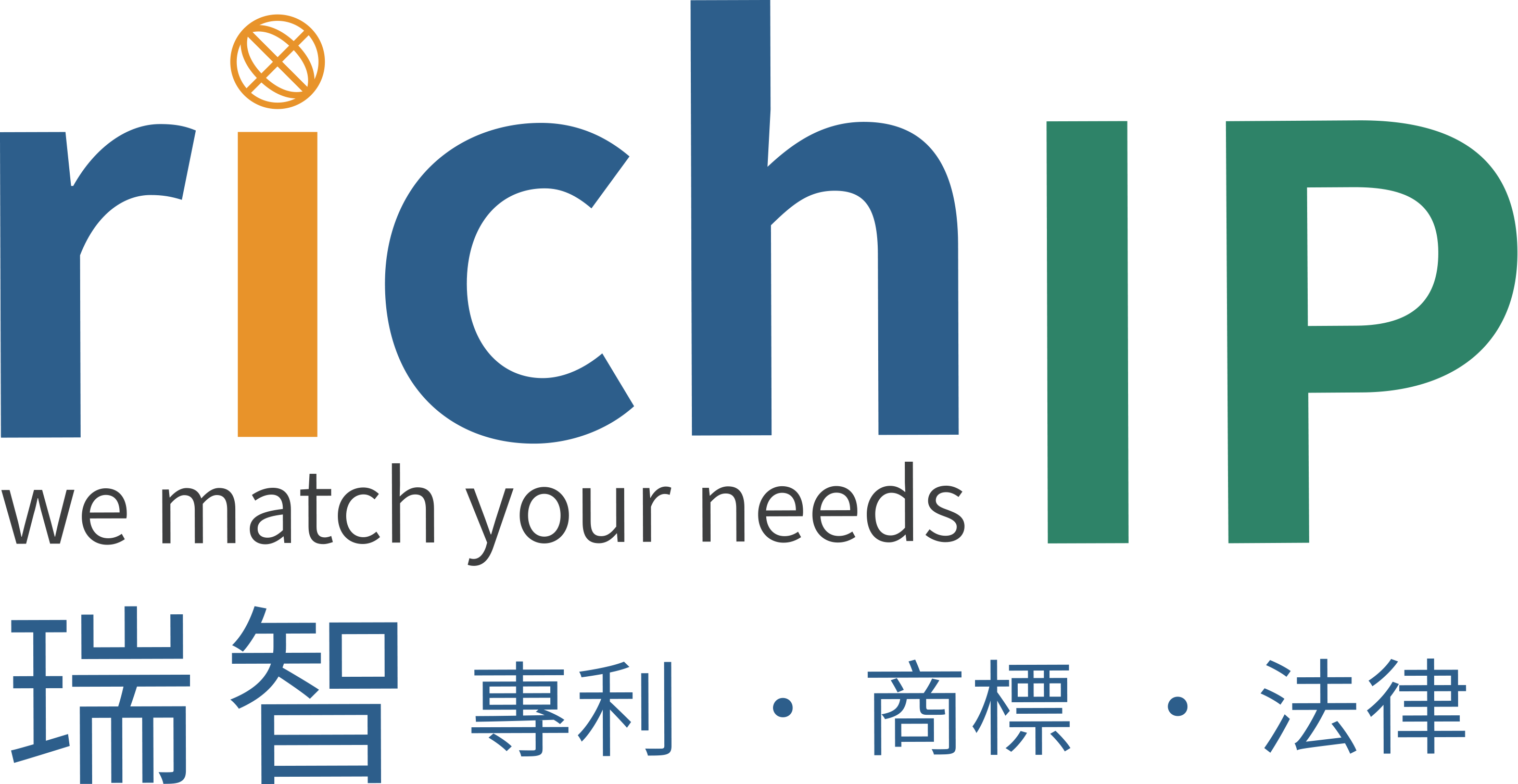News Topics
I. [TW] Statistics of Taiwan Top 100 Patent Applicants in 2021
IV.[CN] Implementation of Trademark Examination and Trial in China
I. Statistics of Taiwan Top 100 Patent Applicants in 2021
Domestic Applicants
As shown in the following table, Taiwan Top 100 domestic patent applicants filed 12,234 applications for patents in 2021, including 9,179 invention patent applications, 2,357 utility-model patent applications , and 698 design patent applications, and the annual increase of patent application reaches about 8%. Top 3 of the domestic patent applicants are Taiwan Semiconductor Manufacturing Company (1,950 applications), AU Optronics Corporation (471 applications), and ACER INCORPORATED (462 applications) in order.
| Invention patent | Utility-model patent | Design patent | Total | Annual increase |
| 9,179 | 2,357 | 698 | 12,234 | 8% |
As shown in the following table, Taiwan Top 100 domestic patent applicants include six (6) banks, twenty-eight (28) schools, and five (5) research institute. Top 3 of the banks are Mega International Commercial Bank (165 applications), China Trust Commercial Bank (155 applications), and Taiwan Cooperative Bank (144 applications) in order. Top 3 of the schools are Taipei City University of Science and Technology (170 applications), National Yang Ming Chiao Tung University (141 applications), and National Cheng Kung University (113 applications) in order. Top 3 of the research institutes are Industrial Technology Research Institute (404 applications), Metal Industries Research & Development Centre (89 applications), and Institute of Nuclear Energy Research, AEC (47 applications) in order.
| Champion | Runner-up | Second runner-up | |
| Banks | Mega International Commercial Bank
(165 applications) |
China Trust Commercial Bank
(155 applications) |
Taiwan Cooperative Bank
(144 applications) |
| Schools | Taipei City University of Science and Technology
(170 applications) |
National Yang Ming Chiao Tung University
(141 applications) |
National Cheng Kung University
(113 applications) |
| Research institutes | Industrial Technology Research Institute
(404 applications) |
Metal Industries Research & Development Centre
(89 applications) |
Institute of Nuclear Energy Research, AEC
(47 applications) |
Foreign Applicants
As shown in the following table, Taiwan Top 100 foreign patent applicants filed 14,149 applications for patents 2021, including 12,335 invention patent applications, 148 utility-model patent applications , and 1,666 design patent applications, and the annual increase of patent application reaches about 5%. Top 3 of the foreign patent applicants are Qualcomm (845 applications), APPLIED MATERIALS (793 applications), and NITTO DENKO CORPORATION (529 applications) in order.
| Invention patent | Utility-model patent | Design patent | Total | Annual increase |
| 12,335 | 148 | 1,666 | 14,149 | 5% |
References
Hyperlink: TIPO’s Press Release (in Chinese)
Dr. Cross Liu
Executive Manager of RichIP Group
II. Canadian Intellectual Property Office (CIPO) became a Digital Access Service (DAS) depositing office for patent applications
The Canadian Intellectual Property Office (hereinafter referred to as CIPO) announced that it would become a depositing office for patent applications using the World Intellectual Property Organization (WIPO) Digital Access Service (DAS), effective February 1, 2022.
When an applicant files patent applications for the same invention in different countries, the later application(s) may enjoy the benefit of priority based on the first application. Since the priority claim involves the patent offices of at least two countries, it is important to exchange priority documents easily and securely between these patent offices. In practice, the patent offices of various countries may adopt two exchange channels: DAS and Priority Document Exchange (PDX).
DAS was created and managed by the International Bureau (IB) of WIPO to provide services for exchanging priority documents between patent offices of various countries (area). DAS is operated by two offices: the depositing office and the accessing office. The depositing office is usually the patent office that receives the first-filed application, also known as the Office of First Filing (OFF). Applicants may request the depositing office to provide priority documents through DAS. The accessing office is usually the patent office that receives the later-filed application and may obtain the priority document through DAS without directly submitting a copy of the priority document (certified copy).
CIPO has been an accessing office for patent applications since October 30, 2019, and it has also been a depositing office since February 1, 2022. The applicant may request that their priority documents be uploaded to DAS at the time of filing the first application with CIPO. If applicants need to make a DAS request after filing, they can request to upload documents to DAS by using CIPO’s new document request form. Accordingly, other patent offices (i.e., the accessing office) of the later-filed application can search through DAS to obtain the priority document.
The applicants may save time and efforts to claim priority easily for their later-filed applications in other countries based on the first-filed application with CIPO through the service of DAS.
References
Hyperlink:Taiwan Intellectual Property Office
Hyperlink:Canadian Intellectual Property Office
Jason hung
Patent Counselor of RichIP Group
III. A multiple dependent claim serving as basis for another multiple dependent claim will no longer be allowed in Japan
In order to reduce the patent examination burden of Japan Patent Office (JPO) and harmonize Japanese patent examination practices with other countries’, JPO announced revisions to Enforcement Rules of Invention Patent Act and Enforcement Rules of Utility Model Patent Act on February 25, 2022, and the revisions will come into force on April 1, 2022.
Specifically, in accordance with the order of Ministry of Economy, Trade and Industry (METI), Enforcement Rules of Invention Patent Act was amended by adding the Fifth Subparagraph stipulating “a multiple dependent claim shall not serve as a basis for any other multiple dependent claim” into Article 24-3 on the basis of Patent Act, Article 36, Paragraph 6, Subparagraph 4, while Article 4 of Enforcement Rules of Utility Model Patent Act was amended correspondingly.
The effect of the revisions is not retroactive, which means that the revisions will only apply to patent applications filed on and after April 1, 2022. Nevertheless, the revisions will not apply to divisional applications filed on and after April 1, 2022 whose parent application is filed before April 1, 2022.
References
Jason hung
Patent Counselor of RichIP Group
IV. Implementation of Trademark Examination and Trial in China
China National Intellectual Property Administration(CNIPA) has implemented the “Trademark Examination and Trail Guidelines” and abolished the “Trademark Examination and Trial Standards” since January 1, 2022. The “Trademark Examination and Trail Guidelines” are divided into two parts, “Formality Examination and routine works” and “Trademark Examination and Trail”.
About the first part
The first part sorts and optimizes the system of the existing processes of the formality examination standards and work procedures, with a total of twenty-five chapters, and is divided into five sections as follows:
- The first section “Formality requirements of Trademark application”
This section Introduces the formality requirements of Trademark application, including Trademark registration, revocation, opposition and review.
- The second section “Classification of goods and services, and the elements of Trademark search”
This section respectively classifies and describes goods and services, trademark text, and trademark image search such that the applicant may fill in the category and name of the goods in accordance with the prescribed goods classification table when applying for and registering a trademark.
- The third section “Examination of other trademark affairs”
The section focuses on explaining the disputes over civil rights disposition in practice during trademark transfer or assignment.
- The fourth section “Examination of Madrid Agreement concerning the International Registration of Trademarks”
The section summarizes the relevant regulations according to China intellectual property rights and “Protocol Relating to the Madrid Agreement concerning the International Registration of Marks”, which comprises the examination contents and specific requirements of the entire scope of the registration examination.
- The fifth section “Processes of trademark application”
This section completely describes the application process to CNIPA, and systematically sorts out regulations regarding processing of document, fees, file management, electronic applications or the likes.
About the second part
The second part acts as the substantive standard of trademark examination and trial, with a total of nineteen chapters, which is composed on the basis of the “Trademark Examination and Trial Standards”. The primary highlights of the second part are organized as the following three items:
- Effectively regulating the order of trademark application and registration
The second part focuses on combating malicious trademark applications, restricting trademark agencies from improperly squatting trademarks and hoarding trademarks or the likes. Also, the details make specific regulations for reasonable submission of trademark registration applications to build a fair and equitable market.
- Enrich the relevant content to meet Trademark Act
The second part also enriches and completes necessary examination details regarding, for example, the prohibited matters of trademark logo, , to meet Trademark Act effective as from 2019.
- Relevant regulations of trademark maintenance
The second part also completes the relevant standards of trademark maintenance, cancellation or the like after application such that trademark practitioners can have a basis for raising opinions, invalidation or revocation, and avoid damaging the rights and interests of trademark owners due to inappropriate reasons.
References
Hyperlink:Trademark Examination and Trail Guidelines
Howard-Pong
Patent Counselor of RichIP Group

